Treatment with the help of the patient’s own information
in the BICOM® mobile VET bioresonance device
In contrast to other “frequency therapy devices”, BICOM® bioresonance is a method that is highly individual and perfectly tailored to the needs of the patient through the use of the patient’s own information and the possibility of testing specific wave patterns for resonance.
The patient’s own pathological and physiological information is recorded using special applicators and fed into the BICOM® mobile VET.
Depending on the therapy program, the specific wave pattern as a carrier of information is amplified, weakened or inverted and transmitted back to the patient in modulated form, which means that the transmission of information changes in clarity depending on the modulation or it disappears completely.
The treatment signals continuously adapt to the changing pathological situation of the patient. As the therapy progresses, the body’s ability to regulate is reactivated.
Find out more about this topic at our regular events. Together with veterinarians and animal naturopaths, we offer various face-to-face and online events .
The BICOM® bioresonance method is a cause-oriented, holistic treatment concept. It can narrow down the cause of the health problem in animals and find out even the hidden causes of the clinical picture.
Animals have a natural regulatory system that can also compensate for unusual influences. However, even good self-healing powers eventually reach their limits. Persistent exposure to allergens, environmental toxins, fungi, viruses, bacteria or stress and changed living conditions weaken the immune system and are often the cause of an illness. In particular, fungal infestation on the skin or chronic diseases in general are not always due to a breeding-related genetic defect, but are signs of a disturbed immune system.
The BICOM® bioresonance method is the key to successful diagnosis and therapy, especially for animals that cannot tell us exactly where it hurts or what the symptoms are. It is a gentle form of therapy that can be carried out without side effects and without additional stress for the animal.
The BICOM® mobile VET records the bioenergetic state of the animal, processes the information it contains and returns modified vibrations / therapy frequency patterns to the animal. Symptoms and stress can be diagnosed and targeted therapy can be initiated.
Through the use of endogenous and exogenous substances, the body’s own self-healing powers can be activated and imbalances that have existed for a long time can also be regulated.
REGUMED Medizintechnik are pioneers of the BICOM® bioresonance method. More than 30,000 therapists worldwide, well over 10,000 of them in Germany, successfully use their therapy concept.
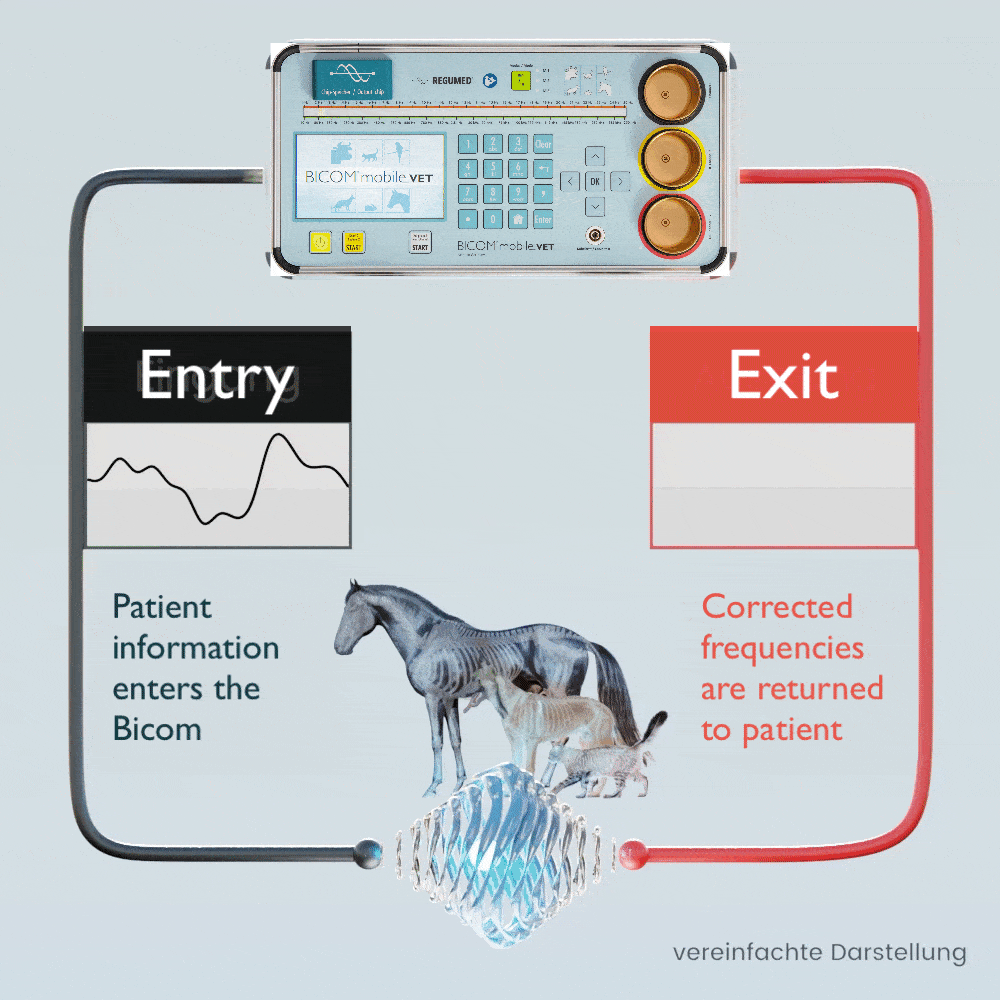
Biophysical basics of the bioresonance method
Life is only possible when three conditions are met: matter, energy and information.
We also find these aspects in conventional medicine, both in diagnostics and in therapy. For example, every drug is also a carrier of information.
Information is neither energy nor matter, it is immaterial and comparable to the meaning of a message from a sending to a receiving system.
In addition to the electrical processes in the receptor proteins and biomembranes in general, electromagnetic interactions through light (biophotons) also play a role in cell communication and the transmission of information.
Specific electromagnetic wave patterns act as information carriers. These wave patterns can be modulated by the BICOM® device in order to eliminate disturbing or stressful information in an organism.
The goal is to restore the free flow of healing information (cell communication) and thus support the self-regulation of the organism and the self-healing powers.
Individual, patient-specific information or information from native substances, digitized substances or information stored on storage media can be used for therapy.
What your colleagues are saying…
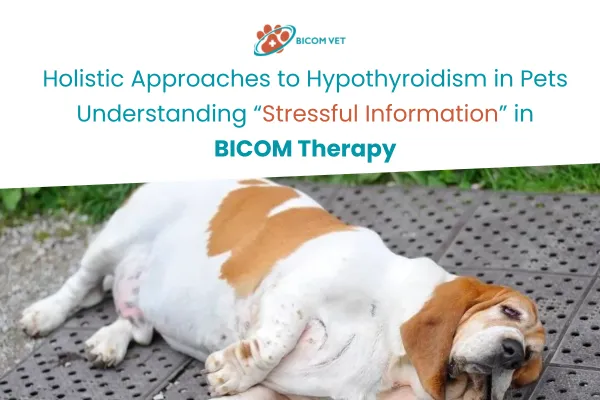
Holistic Approaches to Hypothyroidism in Pets: Understanding Stressful Information in BICOM Therapy
Holistic Approaches to Hypothyroidism in Pets: Understanding “Stressful Information” in BICOM Therapy

Hypothyroidism in pets can be confusing and stressful for families. This guide explains how holistic veterinary medicine, and specifically BICOM therapy, may be used as a complementary approach to support overall wellbeing alongside your vet’s care. We’ll also clarify what “stressful information” means in bioenergetic diagnostics, so you can make informed, responsible choices.
Quick note on honesty and safety: Bioresonance is not an approved diagnostic or medical treatment; leading authorities do not recognise it for disease diagnosis or cure. It should not replace your veterinarian’s examination, testing, or prescribed medication. We present it here as complementary therapy only. bioresonance.vet
What is hypothyroidism in pets?
Hypothyroidism typically refers to a low-producing thyroid. In dogs (and less commonly cats), it may show up as low energy, weight changes, skin or coat issues, or feeling cold. Your primary vet confirms the condition through clinical examination and blood tests. Medications prescribed by your vet remain the standard of care.
Holistic care can sit alongside that plan, focusing on comfort, stress reduction, and overall balance. That’s where BICOM therapy, used in holistic veterinary medicine, enters the conversation as a supportive, non-invasive option.
Where holistic veterinary medicine fits
Holistic veterinary medicine aims to view the animal as a whole body, behaviour, environment, and lifestyle. Within that context, BICOM therapy is presented by many clinics as a gentle, cause-oriented, non-invasive tool to explore patterns of imbalance and to harmonise bioenergetic signals. It is framed as supportive care, not a substitute for veterinary diagnosis or thyroid medication.
Transparency matters: the bioresonance.vet site itself publishes cautionary articles stating that bioresonance is not scientifically validated as a medical treatment and isn’t an approved diagnostic tool. This aligns with our commitment not to mislead readers.
What is BICOM therapy?
BICOM® bioresonance is described as a holistic, frequency-based system. Practitioners say it detects and works with a pet’s unique frequency patterns to encourage balance. In veterinary settings, it’s marketed as non-invasive and gentle for dogs, cats, and even horses.
From a wellness standpoint, owners often seek sessions because the experience is calm, contact-based, and easy for most animals to tolerate. Still, it is complementary, it doesn’t diagnose disease, and it shouldn’t delay conventional thyroid care.
Bioenergetic diagnostics and “stressful information”, explained
Within BICOM-style bioenergetic diagnostics, practitioners often refer to “stressful information”. In simple terms, this means signals believed to correlate with burdens that may disturb balance, think allergens, environmental exposures, or microbial signatures. Addressing those signals is approached in a stepwise order so the pet isn’t overwhelmed.
The general sequence used by practitioners
First, open “elimination” pathways and remove therapy blockages.
Next, address extracellular burdens (for example, allergens, chemicals, fungi, some bacteria).
Finally, address intracellular burdens (for example, viruses, intracellular bacteria, heavy metals).
This “outside-to-inside” logic aims to reduce reactivity and ease the system into deeper work.
Common combination patterns practitioners test
In practice, several stressors can appear together. Examples that are often screened for include gluten/gliadin plus yeasts; dairy proteins plus parasites; and clusters that may include histamine reactivity. These combinations are tested and treated individually until they no longer “resonate” on the device, meaning the signal isn’t detected by the chosen method.
Takeaway for pet parents: this doesn’t replace lab tests or allergy diagnosis. It’s a bioenergetic lens some holistic practitioners use to guide supportive care. Always coordinate with your vet.
How this relates to hypothyroidism and Hashimoto’s thyroiditis
Some dogs develop autoimmune thyroiditis (often labelled Hashimoto’s in human medicine). In BICOM practice, when a pet already has a vet-diagnosed thyroid condition, the bioenergetic work focuses on mapping and harmonising stressful information that might be contributing to overall discomfort, skin issues, digestion, or energy. It’s not a cure for hypothyroidism; it’s a supportive layer while your vet manages hormones and monitors labs.
Inside a typical BICOM-style plan for a thyroid case
Below is a plain-English translation of how many practitioners structure support sessions when hypothyroidism is present. Specific steps and settings are individualised.
1) Foundation and gentle start
Begin with basic harmonising programmes for the first 1–2 sessions.
Focus on opening “elimination” pathways and addressing therapy blockages (for example, scar interference fields, jaw/vertebral restrictions, geopathic stress, or meridian/chakra blocks as defined in their framework).
Keep sessions short for seniors or sensitive animals.
2) Address extracellular burdens
Explore allergic signals, fungi, extracellular bacteria, parasites, and chemicals.
Treat clusters one by one; retest until each component is quiet.
Adjust time and amplification to reduce the chance of initial aggravations.
3) Address intracellular burdens
Explore viral signals, intracellular bacteria, and environmental toxins (for example, heavy metals in their model).
Move into this phase only after extracellular work is stable.
4) Harmonise and stabilise
Conclude sessions with global harmonisation and stabilisation using tools such as “5-element” balancing in the BICOM system.
Typical intervals: every 1–2 weeks, adjusted for species and age.
Session pacing matters: the aim is to avoid overtreatment and keep your pet comfortable while complementing the veterinary plan.
What you can expect at bioresonance vet
Bioresonance vet emphasises BICOM bioresonance as a cause-oriented, holistic treatment concept for animals, offered through practitioner partnerships and events for vets and pet owners. Sessions are non-invasive and meant to support overall wellbeing, not to diagnose or replace medical care.
Services and educational touchpoints
For vets: Regular online and in-person events exploring BICOM’s approach to animal health.
For pet owners: Articles and guides about bioresonance for cats, dogs, and general wellness topics.
Packages and pricing context
Some clinics that offer BICOM access provide multi-session packages aligned with average course lengths. Packages can be more economical than single bookings, useful if your practitioner recommends a series over several weeks. Please ask directly about current options and what’s included.
Clear policy reminder: the site’s own content reiterates that bioresonance is not an approved diagnostic tool and evidence remains limited, so you should always keep your primary vet at the centre of thyroid care.
How to integrate BICOM complementary care with your vet’s thyroid plan
To keep care safe and coordinated, consider this sequence:
Start with your vet. Ensure proper diagnosis through examination and thyroid blood panels; discuss medication if indicated.
Share information. If you pursue BICOM sessions, give your practitioner the vet’s diagnosis and medication list.
Set goals. Agree on supportive goals of comfort, coat quality, calm behaviour, or digestive ease, rather than disease claims.
Monitor together. Keep vet rechecks for T4/TSH or other labs as recommended, and tell your vet about any supplements or session frequency.
Adjust mindfully. If your pet shows signs of fatigue, restlessness, or any worsening, check in with your vet promptly.
This keeps the complementary work transparent and aligned with conventional care standards.
Frequently asked clarifiers (short and practical)
Is BICOM therapy safe?
It’s presented as gentle and non-invasive. That said, lack of strong evidence means it should be treated as adjunctive wellness support, not a medical treatment.
Can BICOM diagnose hypothyroidism or replace levothyroxine?
No. It is not an approved diagnostic and should not replace prescribed medications.
Is there scientific consensus?
Major medical authorities do not recognise bioresonance as a valid treatment. Choosing it should not delay veterinary diagnosis or evidence-based therapy.
Practical tips before your first session
Bring records: Diagnosis, meds, supplements, and any allergy history help practitioners individualise supportive work.
Expect a series: Many pets attend sessions every 1–2 weeks initially; ask about a package if recommended.
Watch for changes: Track energy, coat, stools, sleep, and mood in a simple log to discuss with your vet and practitioner.
Keep it balanced: Maintain your pet’s medication as prescribed and follow vet recheck schedules.
Ready to talk?
If you’re exploring complementary support for hypothyroidism in pets and want to understand how BICOM fits into a broader, vet-led plan, our team is happy to help. Reach out with your questions or ask about upcoming vet and pet-owner events.
Pet owners: Contact us with your vet’s diagnosis to discuss a supportive session plan. bioresonance.vet
Vets: Join an event to see how bioenergetic diagnostics and “stressful information” mapping are presented in practice.bioresonance.vet
Treatment Priorities
For gentle and optimal treatment of the causes of diseases in animals
The BICOM® bioresonance method is predestined for use with large and farm animals such as horses , but also with dogs , cats and small animals. The treatment focus of the BICOM® mobile VET is wide-ranging. It is now used for many indications.
It recognises health deficits at an early stage and is used, among other things, for the following symptoms:
sweet itch
Feed intolerances
allergies and related diseases
COB/COPD
leishmaniasis
Lyme disease
anaplasmosis
lameness in horses
hoof ulcer
Poisoning by poisoned baits, plants etc.
mauke
Feline infectious peritonitis (FIP)
Cat flu/cat disease
eye/conjunctivitis
and much more
Get advice now!
Our experts are happy to be there for you personally
Our BICOM® bioresonance experts are available to answer any questions you may have
and will be happy to advise you personally and individually.
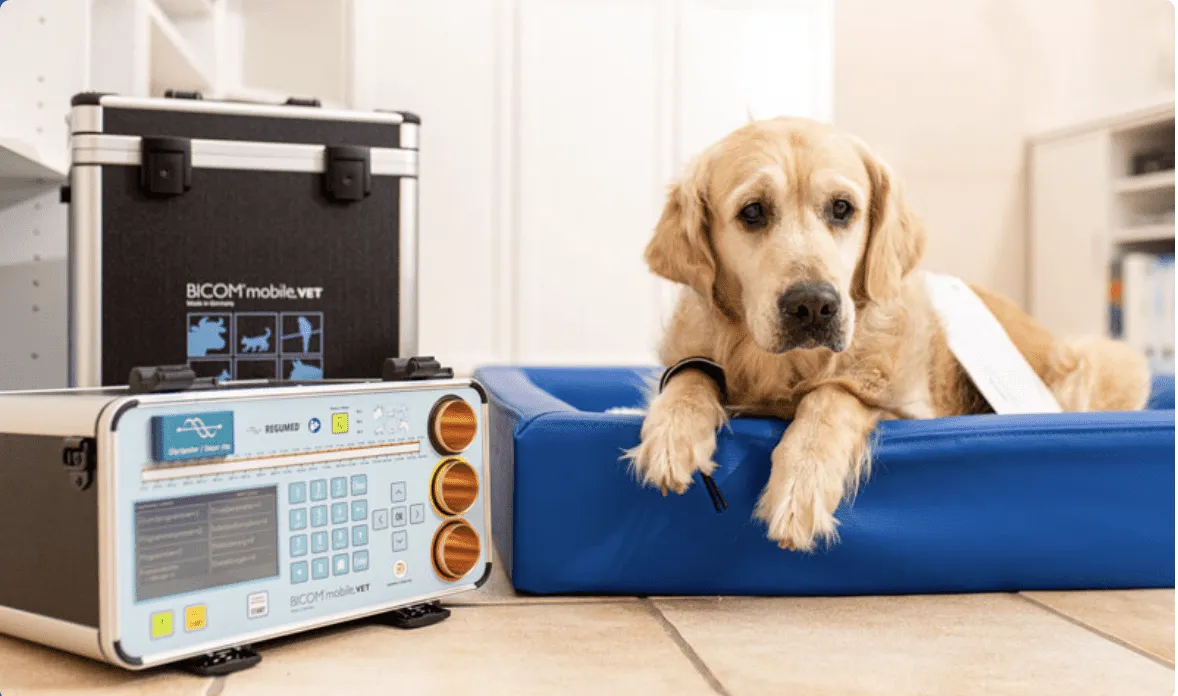
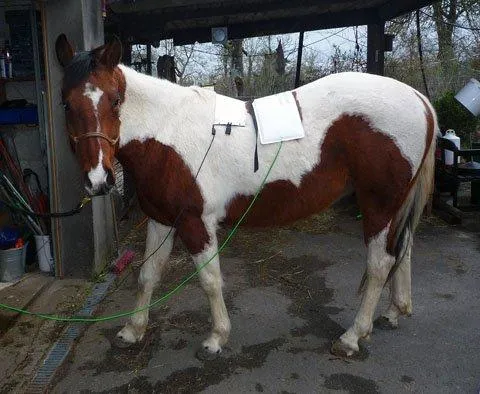


Request more information
Quick Links
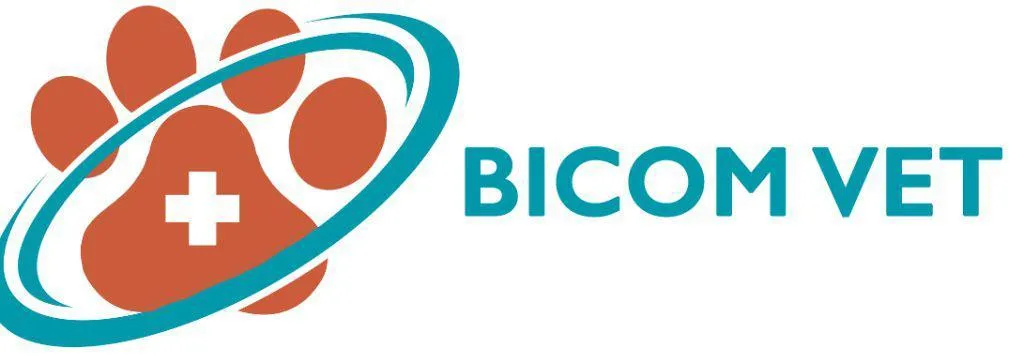
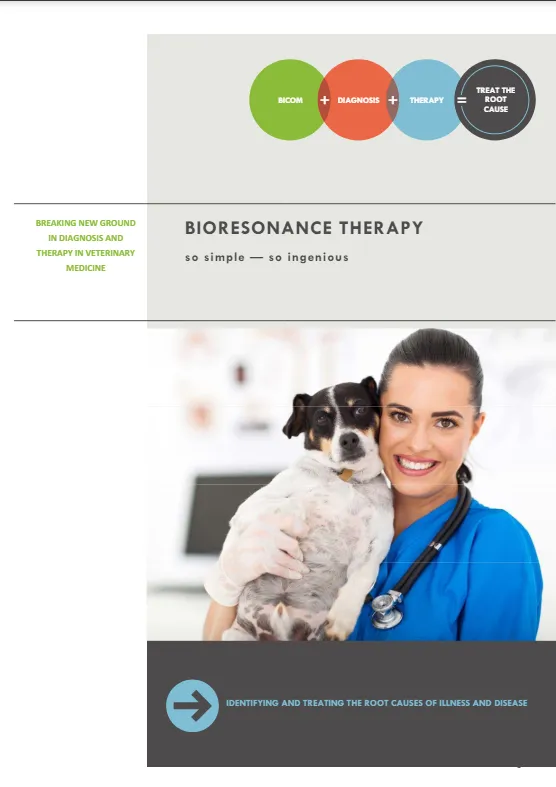
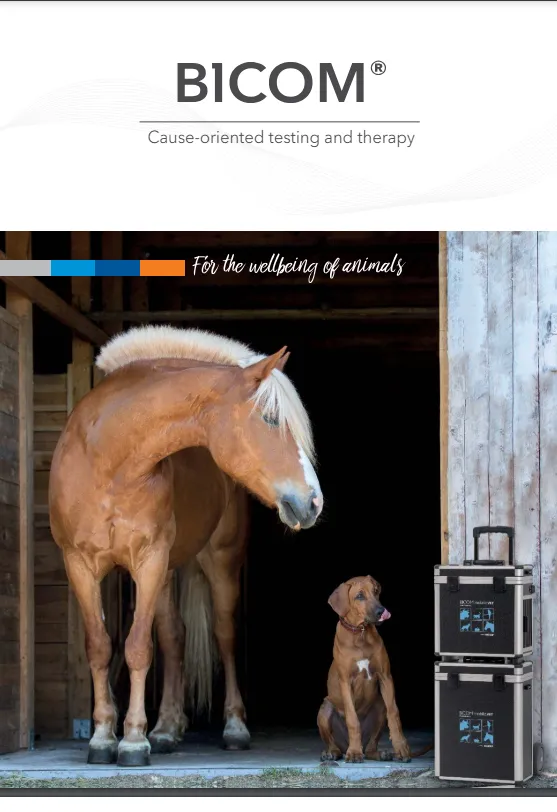

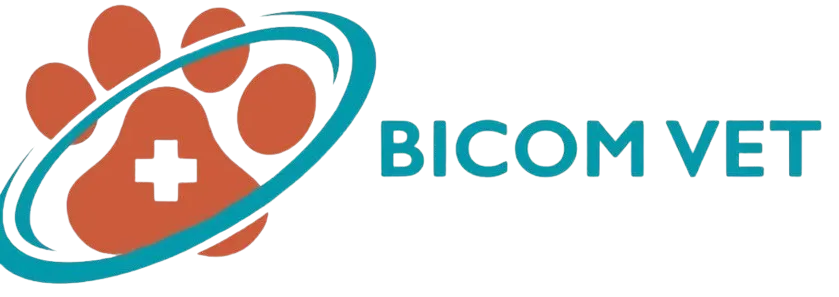
Facebook
Instagram
Mail